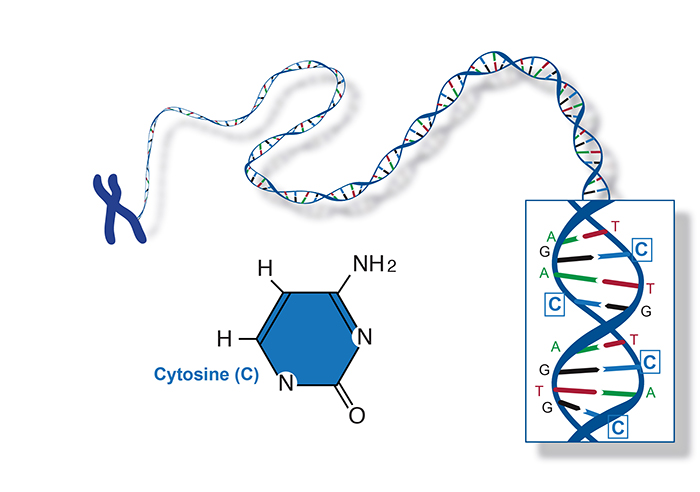![An oxidized form of the DNA base cytosine has been found to be stable incorporated into the mouse genome. [Darryl Leja, NHGRI]](https://genengnews.com/wp-content/uploads/2018/08/NHGRI852882318024019-1.jpg)
An oxidized form of the DNA base cytosine has been found to be stable incorporated into the mouse genome. [Darryl Leja, NHGRI]
Since the discovery of the structure of DNA over 60 years ago, it has been well established that the genetic code comprises four distinct nucleic acids: A, C, T, and G (adenine, cytosine, thymine, and guanine). In the time since that monumental revelation, scientists have found numerous modifications that occur to DNA bases, most of which are transient and, if not readily removed, capable of introducing genetic mutations into replicating DNA strands.
However, every once in a while, researchers come across a modified DNA base that seems to have a larger role than ultimately mutating the genetic pool. Take, for example, the molecule 5-formylcytosine (5fC). Scientists from the University of Cambridge and the Babraham Institute have published a report indicating that this naturally occurring modified DNA base appears to be stably incorporated into the DNA of mammalian tissues.
“This modification to DNA is found in very specific positions in the genome—the places which regulate genes,” explained lead author Martin Bachman, Ph.D., who conducted the research behind the report while at Cambridge's Department of Chemistry. “In addition, [this modification has] been found in every tissue in the body—albeit in very low levels.”
The Cambridge team's findings appeared June 22 in Nature Chemical Biology through an article entitled “5-Formylcytosine can be a stable DNA modification in mammals.”
While the researchers are still trying to determine the exact function 5fC, they hypothesize that the molecule’s physical position in the genome is indicative of having a role in gene activity.
“If 5fC is present in the DNA of all tissues, it is probably there for a reason,” stated Shankar Balasubramanian, Ph.D., professor in the Department of Chemistry at the University of Cambridge and senior author on the current study. “It had been thought this modification was solely a short-lived intermediate, but the fact that we've demonstrated it can be stable in living tissue shows that it could regulate gene expression and potentially signal other events in cells.”
The investigators used high-resolution mass spectrometry to examine the levels of 5fC in adult and embryonic mouse tissues, in addition to mouse embryonic stem cells. They found that 5fC is present in all tissues, but is very rare, making it difficult to detect.
To increase detection sensitivity, the scientists used a method of feeding cultured cells and living mice with an amino acid called L-methionine, enriched for naturally occurring stable isotopes of carbon and hydrogen, and measuring the uptake of these isotopes to 5fC in DNA. The lack of uptake in the nondividing adult brain tissue pointed to the fact that 5fC can be a stable modification—were it a transient molecule, uptake of the isotopes would be high.
The Cambridge scientists believe that 5fC might be acting epigenetically to alter the way DNA is recognized for gene expression.
“Unmodified DNA interacts with a specific set of proteins, and the presence of 5fC could change these interactions either directly or indirectly by changing the shape of the DNA duplex,” said Dr. Bachman. “A different shape means that a DNA molecule could then attract different proteins and transcription factors, which could in turn change the way that genes are expressed.”
Whatever the ultimate function of 5fC is determined to be, Dr. Balasubramanian is confident that his team's discovery will have a profound impact on the underlying molecular mechanisms of gene expression.
“This will alter the thinking of people in the study of development and the role that these modifications may play in the development of certain diseases,” asserted Dr. Balasubramanian. “While work is continuing in determining the exact function of this 'extra' base, its position in the genome suggests that it has a key role in the regulation of gene expression.”



